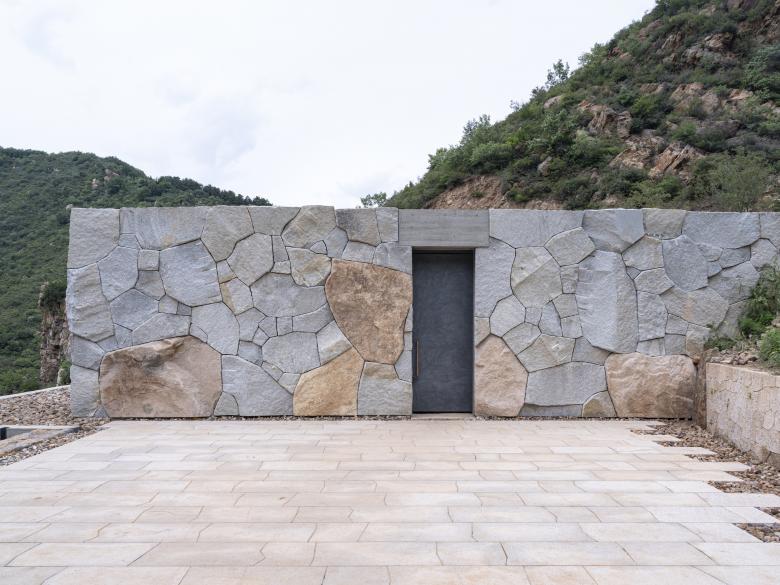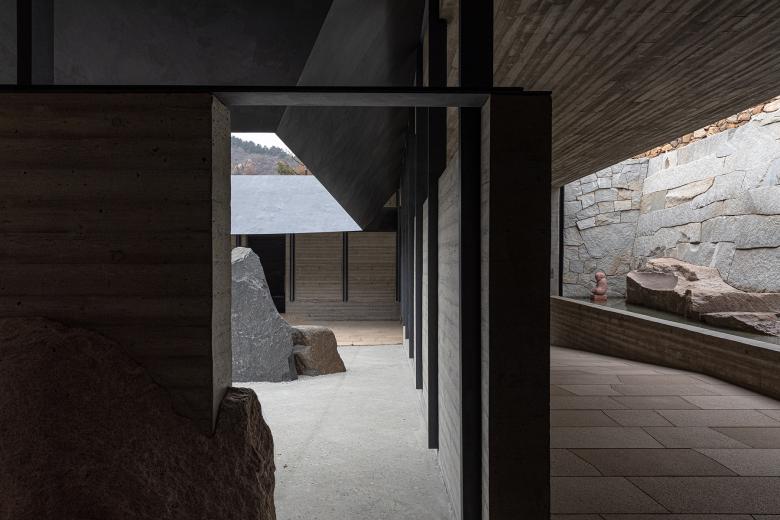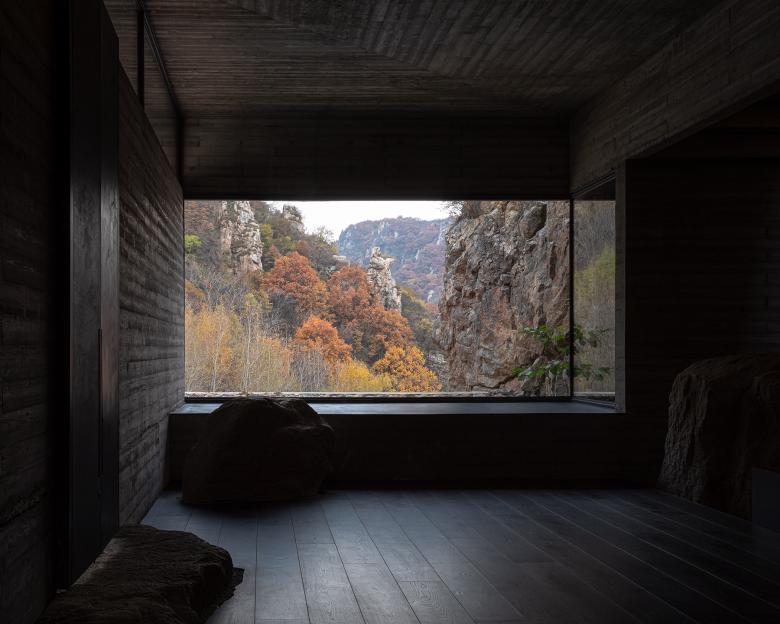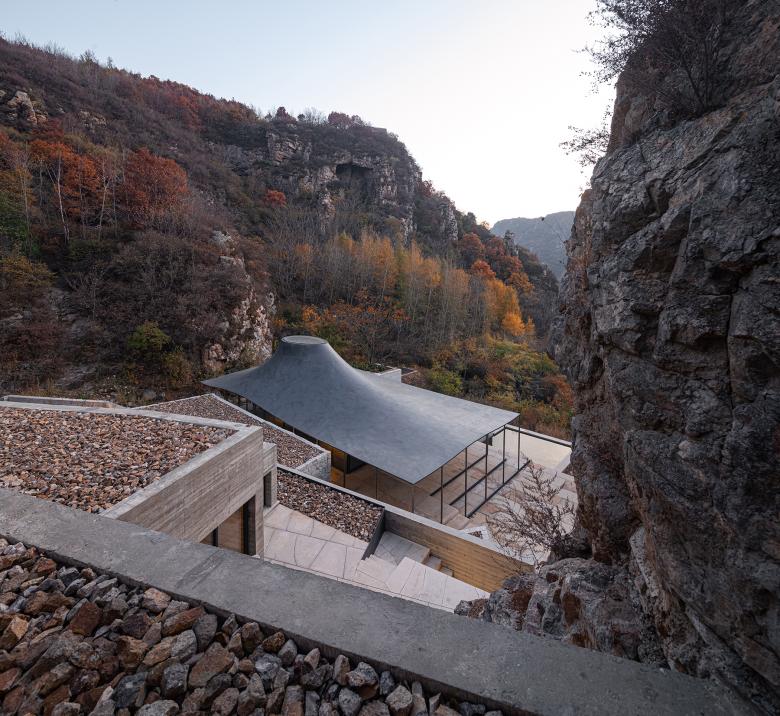Meditation on Space and Material
The Upper Cloister is a modern-day interpretation of an ancient temple-complex, where the urban middle class from Beijing can find rest and relaxation within a grandiose natural and cultural landscape with a view of The Great Wall. It is located halfway between the Chinese capital and Chengde, the former summer residence of the Qing emperors. Although the surrounding landscape includes historical references such as The Great Wall, the setting is also defined by recent urbanization as reflected in a housing estate built by Aranya, the hip real estate developer that commissioned the Upper Cloister.
Liu Yichun of Atelier Deshaus drew inspiration for the architectural design from traditional Buddhist Chan culture (Zen in Japan), but also added his own ideas to these references; especially regarding the selection of materials and the contemporary organization of space. The property is located on a steep hillside opening southwards towards a valley. Following the conceptual model of the Foguang Temple (9th century, Tang Dynasty) in Shanxi Province, the individual spatial units in the complex merge into each other in a downward stepping sectional arrangement that follows the topography rather than formal historical models of temple complexes as freestanding pavilions dispersed over topographical platforms.
At the Upper Cloister, the resulting plan of the complex is a composition of interconnected volumes, with only one freestanding, transparent pavilion with an expressive roof standing independently on the lowest platform. The entrance is through a rectangular courtyard articulated with a few solitary boulders. Other rocks are also placed in the subsequent and smaller courtyards, and natural stone also appears in the interior spaces. The rudimentary hewn boulders bring the harsh environment inside and contrast with the rooms made of carefully cast concrete.
On the upper levels, the interiors focus on small courtyard gardens designed as rock compositions and minimal planting by Japanese monk and landscape architect Shunmyō Masuno. The individual spatial units, which follow each other from top to bottom, are realised with few materials: the cascading structural form was cast on site from concrete, the built-in furniture is made of wood, and the walls are partially covered with natural stone cladding prepared with fine stonemasonry into an interlocked polygonal bond in relief.
The building complex is accessed by a multitude of interior and exterior paths and stairs. The paths allow visitors to form their own relationships with the surroundings, providing opportunities for many spatial impressions. The reduced materiality of concrete, natural stone, wood and steel determines the colour scheme of the interior spaces in brown, grey and black, that provides a neutral background for views of the surroundings through the windows. Here, nature is staged, demonstrating time and the natural cycle of life in seasonal change. Further landscape design elements deal sensitively with the traces of human activity by presenting a former, informal coal mine located nearby.
The freestanding, transparent pavilion on the lowest level stands in counterpoint to the compact stepped structure. Its asymmetrical, almost black-coloured funnel-shaped roof form, is made of a steel mesh-reinforced polymer mortar supported by two rows of very slender columns that give the transparent space a meditative atmosphere and together with the roof thematize the duality between light and heavy, open and closed, and organic and geometric.
By deconstructing traditional models and creatively reinterpreting them for present-day uses, Atelier Deshaus offers an anchor point with which the cultural flow from history surfaces in the present via analogies and references. This new interpretation of a historical temple complex, no longer operated by religious sponsors, offers a contemporary place for meditation and concentration as a haven of tranquillity for the urban middle class.
See also interview with Liu Yichun.
Location: Laowa Village, Luanping, Chengde, Hebei Province, China
Architects: Atelier Deshaus
Design Team: Liu Yichun, Shen Wen, Chan Hio Ngai, Wang Longhai, Gong Yu, Zhang Xiaoqi, Wang Yi, Sun Huizhong, Ji Hongliang, Zhang Zhun (structure), Zhang Chongchong (structure)
Structure Consultant: AND Office
Structure and M&E: Beijing Yanhuang International Architecture & Engineering Co., Ltd
Landscape consultant: Shunmyō Masuno + Japan Landscape Consultants (courtyards and gardens), Turenscape (environment)
Statue of Buddha: The Jiangs
Lighting consultant: Zhongchenyuanzhan Lighting Design Co., Ltd, DLX Lighting Design
Design Period: 2016.11–2018.03
Completion: 2018.03–2022.09
Floor area: 615 m2
Client: Aranya Real Estate Development Co., Ltd
Construction: Chengde County Hongsheng Construction & Installation Engineering Co., Ltd, Jimusi Sanjiang Architectural Engineering Co., Ltd
Interior Construction: Beijing Wandan Construction & Installation Engineering Co., Ltd.
Garden Construction: Changzhou Innovation Garden Engineering Co., Ltd.
Intelligent construction and technical development (for the Zen Hall): RoboticPlus.AI
Steel Structure Consultant: Shanghai Dexu Construction Development Co., Ltd
Faux finish: Shanghai Yujia Construction Technology Co., Ltd.
Carbon Fiber Consultant: Shandong Huaye Wind Power Equipment Co., Ltd
Glass Consultant: Shanghai Rilang Doors and Windows Co., Ltd / Shanghai Lanshi Glass Co., Ltd
Stone Consultant: Yiboyuan Sculpture Co., Ltd















